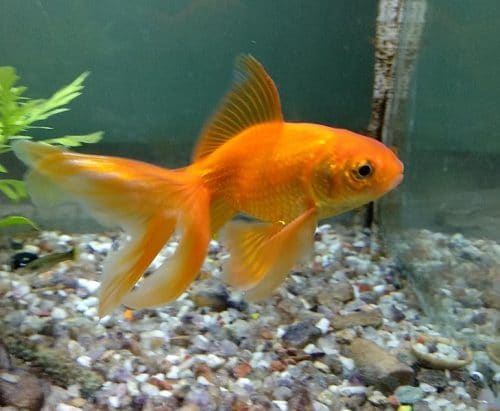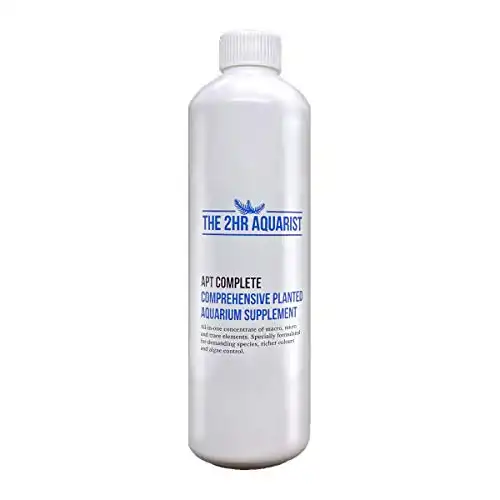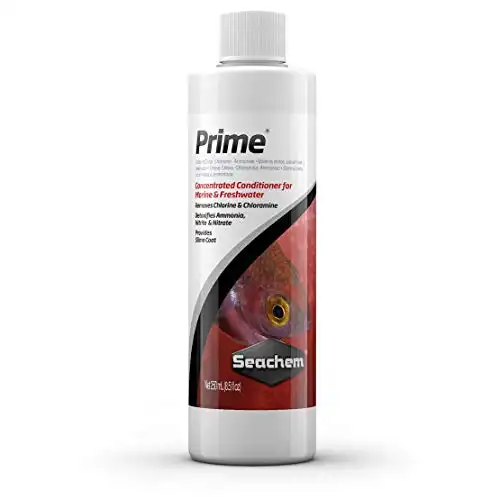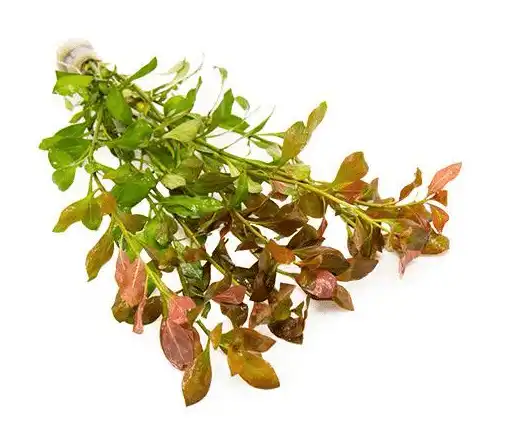Thank you for visiting! By the way… any links on this page that lead to products on Amazon and other stores/partners are affiliate links Aquarium Store Depot earns a commission if you make a purchase.
Looking for an easy to care for red plant? Ludwigia repens may for you then. Reds are a major challenge for beginner planted tank owners due to their more complex care over green aquatic plants. However, this plant bucks the trend with its forgiving nature. Ludwigia repens, or the red leaf ludwigia is a great beginner plant that can be grown under a wide range of different lighting conditions, and with or without CO2 injection. This is one of the best red plants for beginners to start out with. Read on to learn everything you need to know about growing the red leaf ludwigia.
Species Overview
| Scientific Name | Ludwigia repens |
| Common Names | Red leaf ludwigia, red repens, creeping primrose-willow, water primrose |
| Family | Onagraceae |
| Origin | United States of America, Mexico (North and Central America) |
| Skill Level | Easy |
| Lighting | Moderate, but grows best at 100-200 PAR (Umols) |
| Tank Placement | Mid ground & Background |
| Flow Rate | Low, Moderate |
| Temperature Range | 72 – 82°F |
| Height | 8 – 20 inches |
| pH Range | 6.5 – 7.5 |
| Proprogation | Stem cuttings |
| Growth Rate | Fast |
| Feed Type | Column and Root Feeder |
| Co2 Requirement | No |
Origins And Habitat
Ludwigia repens is an amphibious flowering plant from the United States and Mexico in North and Central America. In the wild, it can be found growing in ditches, ponds, and along sandy and muddy stream banks.
What Does They Look Like?

Ludwigia repens is a stunning red stem plant with foliage color that varies from dark green to deep red. Overall color depends a lot on growing conditions, but the leaves on these aquatic plants are mostly green to brownish red.
Color will vary according to the strength of the lighting the plants receive and also the variety of creeping primrose willow you have. These aquatic plants will be greener in low-light tank conditions becoming redder under strong light.
This effect can often be seen where lower leaves remain an olive-green color while leaves towards the top of the tank have a red tint. This beautiful color makes this an ideal specimen plant that captures your attention.
This is an upright but narrow plant, that reaches heights of about 20 inches and grows 2-3 inches across. It has oppositely arranged oval leaves.
Placement And Lighting
Being a fairly tall plant, Ludwigia repens is best grown in the mid ground to background of planted tanks. Although these plants can be grown under pretty low light, they will tend to drop some leaves (especially at the bottom of the stem) under these conditions.
This is a versatile plant that works great in a wide range of aquascapes. They work particularly well as a background plant in nature-style biotopes but also in Dutch Aquascape style planted tanks.
Moderate to strong planted tank lighting will bring out the best colors in this plant and ensure fast and vigorous growth.
What Are Good Tank Mates?
Ludwigia repens works great in most tropical community tanks where peaceful fish species are kept. Although not ideal, it is a fast-growing species and might even survive being fed on occasionally.
Good Tank Mates
Good tank mates for this plant include:
- Most tetras
- Cherry Barbs
- Danios
- Otos
- Corys
- Freshwater shrimp
Basically, any non-herbivorous, tropical freshwater fish that does not disturb the substrate too much will work well with Ludwigia repens, provided they share the same parameter ranges.
Fish Species To Avoid

Avoid keeping fish like silver dollars, goldfish, and Buenos Aires tetras which will feed on this and other aquarium plants in your fish tank. Large, aggressive species like Oscars are likely to damage these delicate plants and are not recommended as fish tank mates.
Feeding and Fertilization
Although not considered a heavy feeder, this plant, like all red species, needs enough iron to maintain healthy growth. A supplement like Seachem Flourish Iron added in small amounts on a weekly basis will provide for these needs.
Ludwigia repens is both a root and water column feeding plant that should be grown in a good quality aqua soil for best results. These aquatic plants will also thrive in dirt substrates capped with gravel.
How Much And How Often To Feed
It is important to remember that a plant’s nutrient needs has a lot to do with how fast it is growing. For example, a plant that is grown under bright light, with a long photoperiod, and added carbon dioxide will naturally need a steady supply of nutrients to keep up with the fast growth it is like to achieve.
In low-tech environments, especially where fish are kept, established red leaf ludwigias will need very little in the way of supplementary feeding. In most cases, a good quality aqua soil will provide all the nutrients these aquatic plants need to thrive. In a high tech environment, the growth of the aquatic plant will accelerate, requiring more nutrients. When it comes to aquarium plant fertilizers, I feel no one does it better than APT Complete. It’s designed for Dutch aquascapers, which makes it perfect for a red plant like this.
Editor's Choice
Made by an aquascaper for aquascapers. This is the best all around aquarium plant fertilizer on the market. Marco and micronutrients in one bottle!
Use Coupon Code ASDComplete for 10% off your order!
Types
Ludwigia repens comes in a variety of subtypes. Here are a few of the more popular variants you will find in stores:
- Ludwigia repens ‘Rubin’ is a popular variety with a rich red color. To get the most out of this form, you will need bright lighting and CO2 injection in your aquarium. The result is a real eye-catching specimen plant with a compact growth form.
- Ludwigia repens ‘Mini Super Red’ is a spectacular compact form with a deep red color, just like its name suggests. These plants do best in hi-tech setups.
- Ludwigia repens ‘Mesakana’ is an orange to red form with larger, more rounded leaves than regular L. repens. These plants require better lighting than other varieties as well but are otherwise just as easy to grow.
Care Requirements
This is a fast-growing stem plant that benefits from being pruned regularly. Trimming encourages a denser growth form, and pruned plants will also develop rooted nodes faster.
Being an upright, narrow growing aquatic plant, it is best to plant Ludwigia repens in groupings to create a dense stand that will create a more dramatic effect in the aquascape. A bunch of stems growing together will also provide more structure and shelter for livestock like shrimp and fish.
Don’t worry if you only have a few stems to start out with, they are easily propagated and you can develop a group fairly quickly. As it does in nature, this plant will grow emersed in shallow tanks if left untrimmed.
Planted Tank Parameters
Red leaf ludwigia repens grows best in slightly acidic water but will survive in neutral to slightly alkaline environments as well. Soft water is preferred but these are hardy plants and will tolerate hard water.
This aquarium plant does best with a growth temperature of 75-79°F but will grow in much cooler environments, just at a slower rate. Although a CO2 system is not strictly necessary, it is advised, particularly when growing these plants under the recommended lighting intensity.
If you are equipped for it, aim for a CO2 injection rate of not more than 30ppm and time your CO2 injection to begin 2 hours before your photoperiod begins in the morning.
Water Quality
Ludwigia repens is a pretty undemanding plant to grow, but it doesn’t appreciate unstable water conditions. When grown in poor quality water, these aquarium plants are likely to melt, and decaying plant material in your fish tank can result in even worse conditions.
To prevent this, stay on top of your regular maintenance routine by performing regular partial water changes. This is especially important in smaller aquariums where fish and other livestock are kept. Remember, the smaller an aquarium is, the faster the water quality can swing.
Use a water conditioner like Seachem prime when adding new water to your aquarium to neutralize harmful chemicals like chlorine in tap water.
Seachem prime is a easy to use and affordable choice when it comes to remove chlorine and chloramines from your tap water. Highly recommended!
Filtration
All planted tanks should have a good filtration system in place to maintain stable and healthy water conditions. These aquatic plants don’t have any special filtration requirements but should be grown at a reasonable distance from your filter’s uptake and outflow to prevent any mechanical damage to the plants.
Plants in general have the potential to generate more ammonia than fish do in mass plantings. If you are planting a heavily planted tank, you should consider a canister filter so you have proper filtration to handle the added bioload from plant waste in the aquarium.
Flow
Being a pretty delicate plant, strong flow is not recommended for these plants. They will show some nice movement in a tank with some current or if grown just ahead of a gentle spray-bar type outflow. Take care not to focus the outflow of your filter directly on these plants as they will tend to fold right over in a strong current.
Aquarium Maintenance
Testing Water Conditions
It is vitally important to test your water quality parameters regularly. Start by testing your water before introducing L. repens to make sure that your parameters are suitable for the plant.
After that, test your water before each water change to determine how stable your water conditions are. Various aquarium test kits are available that you can use at home to test pH, hardness, ammonia, nitrate, and nitrite levels in the water.
How To Set Up Your Aquarium
Red leaf ludwigia repens reaches a height of about 20 inches and might require frequent trimming in shallow tanks. For this reason, medium to large aquariums are best, unless you enjoy growing emersed species of course. A minimum tank size of around 10 gallons or so is recommended.
A good quality aquarium substrate is best, although organic dirt substrates capped in gravel will work well too.
Only finely textured, sand substrates should be avoided because this plant’s roots will not develop strongly or be able to feed well. Fine, compacted substrates can even suffocate the roots.
How To Propagate
Red leaf ludwigia repens is easily propagated in the planted aquarium. Simply take a cutting from a stem that holds a few healthy leaves.
Remove the lower leaves at the node because this is where new roots will develop. Often, however, roots and new stems will develop at nodes, making these the ideal cuttings to take.
Then simply plant your cutting into the substrate using your aquascaping tweezers. In nature, this species will flower and drop seeds when grown emersed.
Health And Disease
Signs Of Health
Ludwigia repens is a naturally soft and somewhat fragile species. Healthy plants will have some red coloration and intact leaves when bought. Healthy aquarium plants should also be developing new growth at the nodes in the form of roots and stems.
Signs Of Ill Health
If possible, avoid plants that show signs of damaged stems, excessive melt, and decaying leaves.
Common Health Issues And Treatment
It is common for red leaf ludwigia repens to melt back when first planted in your aquarium. The plants are usually grown in very different environments and parameters before you buy them and there is a natural adjustment period.
If this happens, don’t panic, the plants will usually recover to establish healthy root systems and grow back stronger. Be sure to remove any dead or dying plant matter before it can foul up your water though.
Plant Pests
Unfortunately, there’s always a chance of introducing unwanted pests when adding new plants to the aquarium. The easiest way to avoid this from the start is to grow tissue culture plants that have been grown under carefully controlled laboratory conditions.
Tissue cultures usually aren’t quite as hardy as regularly grown stock so be sure you have your water parameters where they need to be before introducing them to the system. They also require more aquarium fertilizer to start since they lack the root system that steam cuttings may have.
When introducing regularly grown ludwigias, start by giving the plants a good inspection. Remove any unhealthy-looking leaves or stems and look out for snails while you’re at it.
To be extra-safe, you might want to consider giving your plants a bleach dip in a very mild solution (20 parts water: 1 part bleach) to kill off any pests. Ludwigia repens are delicate plants, however, so don’t go much over a minute in the dip and rinse them off thoroughly before introducing them to your aquascape.
How To Plant
A how to on planting the Ludwigia Repens is best served with a video. This is a straight to the point video by Otter Creek Aquatics and shows you how to maximize your purchase by spliting up the stems into individual pieces when planting.
Where To Buy
Ludwigia is a popular and common aquarium plant that is usually available from local fish stores and online fish stores. I personally recommend purchasing your live plants online from BucePlant. They offer both stem and tissue culture Ludwigia Repens.
Buceplant offers both stem and tissue culture Ludwigia Repens at great prices. A great beginner red plant to try!
FAQS
Do they need CO2?
Ludwigia repens does not strictly require CO2 for healthy growth. That being said, these plants will definitely benefit from the addition of CO2.
How fast do they grow?
The rate of growth in this species will vary according to parameters like temperature, nutrient availability, and water temperature. In most tropical fish tanks, however, these are fast-growing stem plants that will need to be trimmed from time to time.
How do you plant these in gravel?
Ludwigia is quite a delicate plant and should be planted carefully in coarse, gravel substrate to avoid damaging its root system. They are fast-growing plants and will recover well after an initial melt, however. Create a depression in your substrate using your finger or your aquascaping tweezers, place your plant in the depression, root carefully, and then cover lightly with the gravel.
Can they grow floating?
These plants can grow floating, and this one possible way of propagating new cuttings until they’ve developed a root structure. There are much better-looking floating plants though, so you’ll probably want to grow them rooted in the substrate.
Can they grow in cold water?
Ludwigia repens is suitable for use in cool-water aquariums and will survive in pretty cold water, although you can expect the plant to have a much slower growth rate in cold conditions.
Closing Thoughts
Ludwigia repens is a great choice for aquarists looking for a stem plant to add colors to the mid-ground or background of their planted tanks. These plants are pretty beginner-friendly but will do well in high-tech setups with CO2 injections and offer something for aquarium plant growers at all levels.
- About the Author
- Latest Posts
I’m thrilled that you found Aquarium Store Depot! Here you’ll find information on fish, aquariums, and all things aquatics related. I’m a hobbyist (being doing this since I was 11) and here to help other hobbyists thrive with their aquariums! I adhere to a high quality Editorial Process and Review products with real life field usage and practical analysis.









given excellent naration